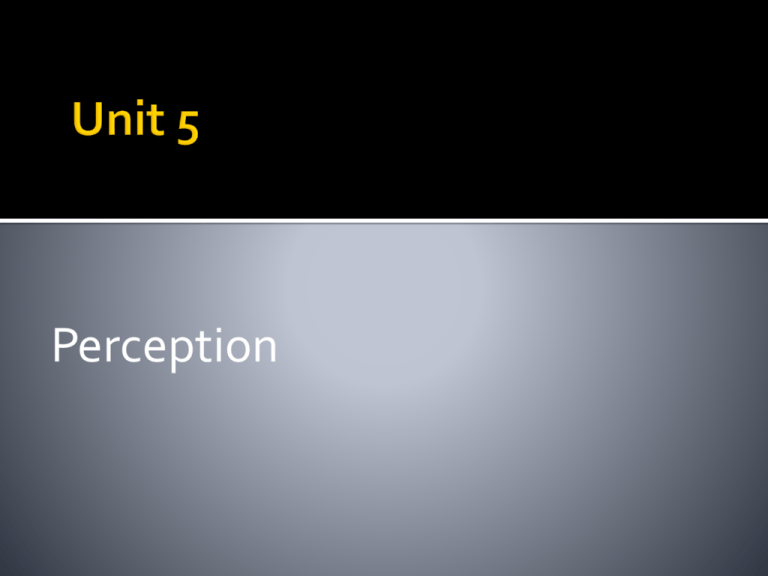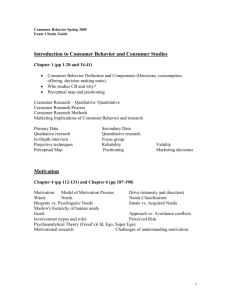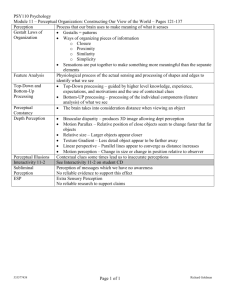Unit-5
advertisement

Perception Introduction Perceptual Selectivity and Perceptual Organisation Perceptual Sets and Perceptual Worlds Halo Effect and Stereotyping Attributions Perception: Errors and Remedies Interpersonal Perception Perception and its Application Organisations in We humans seem to attach meanings, interpretations, values and aims to our actions. What we do in the world depends on how we understand our place in it, depends on how we perceive ourselves and our social and physical environment, depends on how we perceive our circumstances. We explain behaviour with terms like ‘reason', ‘motive', ‘intention', ‘purpose', ‘desire' and so on. We process and interpret the incoming raw data in the light of our experiences, in terms of our current needs and interests, in terms of our knowledge, expectations, beliefs and motives. Perception may be defined as the dynamic psychological process responsible for attending to, organising and interpreting sensory data. From a psychological point of view, the process of sensation, on the one hand, and perception, on the other, work together through what are termed respectively ‘bottom-up' and ‘top-down' processing. Perception is a dynamic process because it involves ordering and attaching meaning to raw sensory data. Our sensory apparatus is bombarded with vast amounts of information. We are constantly sifting and sorting this stream of information, making sense of it and interpreting it. Therefore, it can be said that perception is an information-processing activity. The internal factors affecting perception are: Learning: Our past experience leads to the development of perceptual expectations or perceptual sets which give us predispositions to perceive and to pay attention to some stimuli and to ignore other information. The internal factors affecting perception are: Personality: Our personality traits also predispose us to perceive the world in particular ways, to pay attention to some issues and events and human characteristics and not others. The internal factors affecting perception are: Motivation: We are more likely to perceive as important, and thus to respond to, stimuli that find motivating. We have seen how the perceptual process selects incoming stimuli and organises them into meaningful patterns. This processing is influenced by learning, motivation and personality - factors which give rise to expectations. These expectations, in turn, make us more ready to respond to certain stimuli in certain ways and less ready to respond to others. This readiness to respond is called the individual's perceptual set. A perceptual set is an individual's predisposition to respond to events in a particular manner. A perceptual set is also known as a mental set. As we tend to perceive what we expect to perceive, this can also be called our perceptual expectations. For example, one well-known piece of research compared the pace of life in six countries (Britain, Italy, Indonesia, Japan, Taiwan and the United States) by measuring: The accuracy of clocks in city bank branches, The speed at which city pedestrians walked, and The length of time it took to buy a postage stamp. Japanese cities had the most accurate clocks, the fastest pedestrians and the most efficient post office clerks. Indonesian cities had the least accurate clocks and the slowest pedestrians. Italy had the slowest post office clerks. To change an individual's behaviour - change their perceptions through the information and experiences available to them. The concept of perceptual set or perceptual expectation applies to the ways in which we see other people, events and objects. To understand the nature of perception is to understand, at least in part, the sources and nature of many organisational problems. There are two related and prominent features of the process of people perception: the halo effect and stereotyping. One classic research study noted three conditions under which the halo effect is most marked: 1. when the traits to be perceived are unclear in behavioural expressions 2. When the traits are not frequently encountered by the perceiver, and 3. when the traits have moral implications. Attribution is the process by which we make sense of our environment through our perceptions of causality. An attribution, therefore, is a belief about the cause or causes of an event or an action. Fritz Heider and Harold Kelley developed attribution theory during the 1950s and 1960s. They stated that our understanding of our social world is based on our continual attempts at causal analysis based on how we interpret our experience. The main sources of errors in perception include the following: 1. 2. Not collecting enough information about other people. Basing our judgements on information that is irrelevant or insignificant. The main sources of errors in perception include the following: 3. 4. Seeing what we expect to see and what we want to see and not investigating further. Allowing early information about someone to affect our judgement despite later and contradictory information. The main sources of errors in perception include the following: 5. 6. Accepting stereotypes uncritically. Allowing our own characteristics to affect what we see in others and how we judge them. The main sources of errors in perception include the following: 7. 8. Attempting to decode non-verbal behaviour outside the context in which it appears. Basing attributions on flimsy and potentially irrelevant evidence. Thus, it is clear that errors in perception can be overcome by: 1. 2. Taking more time and avoiding instant or ‘snap’ judgements about others. Collecting and consciously using more information about other people. Thus, it is clear that errors in perception can be overcome by: 3. Developing self-awareness and an understanding of how our personal biases are preferences affect our perceptions and judgements of other people. Thus, it is clear that errors in perception can be overcome by: 4. Checking our attributions - particularly the links we make between aspects of personality and appearance on the one hand and behaviour on the other. Adrian Furnham (1997) argues that the process of making evaluations, judgements or ratings of the performance of employees is subject to a number of systematic perception errors. This is particularly problematic in a performance appraisal context. These are: Central tendency Contrast error Different from me Halo effect Horn effect Initial impression Latest behaviour Lenient or generous rating These are: Performance dimension error Same as me Status effect Strict rating Interpersonal perception begins with the perception of another person, an awareness and appraisal of his attitudes, attributes, intentions and their likely reactions to one's actions. Research was conducted by Zalking and Costello for better understanding of interpersonal perception. The specific characteristics of the perceiver, according to them are: 1. 2. Knowing oneself makes it easier to see other accurately. One's own characteristics affect the characteristics he is likely to see in others. The specific characteristics of the perceiver, according to them are: 3. 4. The person who accepts himself is more likely to be able to see favourable aspects of other people. Accuracy in perceiving others is not a single skill. characteristics of the person being perceived are: 1. The status of the person perceived will greatly influence other's perception of him. 2. The person being perceived is usually placed into categories to simply the viewer’s perceptual activities. Two common categories are status and role. 3. The visible traits of the person will greatly influence the perception of him. People in organisations are always assessing others. Managers must appraise their subordinate's performance, evaluate how co-workers are working. When a new person joins a department he or she is immediately assessed by the other persons. These have organisation. important Employment Interview Performance Appraisals Assessing Level of Effort Assessing Loyalty effect on the Implications of Perception on Performance and Satisfaction Productivity Absenteeism and Turnover Job Satisfaction In short, it can be said that perceptual skills can be enhanced by: 1. 2. 3. 4. Knowing and perceiving oneself accurately. Being emphatic i.e. to see a situation as it is experienced by others. Having positive attitudes, which helps in reduction of perceptual distortions. Enhancing one's self-concept, which helps in perceiving more accurately. In short, it can be said that perceptual skills can be enhanced by: Making a conscious effort to avoid the possible common biases in perception. 6. Communicating with employees to erase incorrect perceptions. 7. Avoiding attributions. 5. The-End







